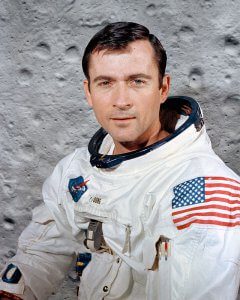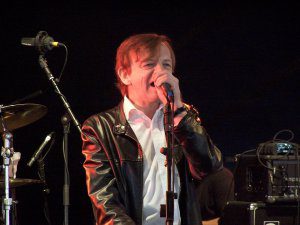When it comes to deciding which US astronaut was the best ever, there is a list of some obvious candidates all of which you would have liked on your crew. Of course the cool-under-fire types such as Apollo 11’s commander Neil Armstrong and the self-rescuing Apollo 13 mission commander Jim Lovell should automatically make the cut. Then there is Apollo 12 and Skylab space station rescue hero Charles “Pete” Conrad who was rated as probably the best space pilot. Meanwhile old school leader types such as Frank Borman, the excellent commander of the first lunar orbital mission, Apollo 8, and the popular Gus Grissom who sadly got killed in the Apollo 1 fire, are also in the running. As you can see, it is already a hard choice. There is however, perhaps one other name who should be added to this list, one who was actually Gus Grissom’s “apprentice” crew mate on the very first Gemini mission: John Young. John Young went on to become one of NASA’s most experienced and accomplished astronauts of all time, taking part in six NASA spaceflights including a mission to the Moon and the maiden test flight of the Space Shuttle. As such, we are thus very sad to report that the great astronaut John young died from pneumonia induced complications at the age of 87 on 5 January 2017.

Astronaut John Young in his Apollo days. Courtesy: NASA
An aeronautical engineering graduate who became a Navy jet flier, followed by a short career as a test pilot, Captain John Young joined the astronaut corps in 1962. The flew with Grissom as a pilot astronaut on Gemini 3 in 1965 and had his own space mission command on Gemini 10 in 1966 – a mission which included making rendezvous with Agena targets and making tethered spacewalks. Young took part in Apollo 10 in May 1969 as the Command module pilot in what would be the dress rehearsal mission for the successful Apollo 11 manned lunar landing attempt in July of that year. John Young got his chance to walk on the Moon himself three years later when he commanded Apollo 16 in 1972.
John Young, with his co-pilot Bob Crippen, flew the very first Space Shuttle mission STS-01 Columbia in 1981 – a mission which was very risky by its very nature and which narrowly avoided disaster due to latterly discovered thermal protection, guidance and vibration issues. By this time Young was already Chief of the Astronaut office at NASA – an office which he ahd held since 1974. His final spaceflight, STS-9 Columbia was in 1983.
Young subsequently became an open critic of some of the management induced safety lapses which occurred on the Space Shuttle programme. Possibly in response to this, Young was removed from flight duty at NASA to become a special assistant to the Johnson Space Centre Director responsible for Engineering, Operations and Safety. Young finally retired from NASA in December 2004 at the age of 74, but maintained his contacts with many of the astronauts in Houston for many years afterwards – helping to transmit his wealth of spaceflight experience to them.
Young married twice and had two children by his first marriage. We give our salute to the venerated veteran astronaut John Young and we give our condolences to his family and friends.
Post script: There are now just four astronauts left alive who have walked on the Moon: Buzz Aldrin (Apollo 11), David Scott (Apollo 15), Charlie Duke (Apollo 16), Harrison Schmitt (Apollo 17).
…As we say goodbye to Ursula Le Guin and especially to The Fall’s Mark E. Smith: a “strange kind of antimatter national treasure”
While some mourned the death of the influential sci-fi writer Ursula Le Guin In late January, others were more saddened that Mark E. Smith, the famously irascible, curmudgeonly, and prematurely aged front man of the post-punk rock group “The Fall”, had finally died after a long battle with lung and kidney cancer at the age of 60. Smith, who was once described as a “strange kind of antimatter national treasure” was famously prone to hire and especially fire at will: he once fired a sound man for ordering a salad for himself, and sacked band mate Mark Riley (who later became a BBC disc jockey) on Riley’s wedding day.

Mark E. Smth as front man of The Fall in 2008. Courtesy: Wikipedia
Unsurprisingly, Mark E. Smith found it difficult to keep both band mates and wives (he was married three times) and was the only original member of the band which was aptly originally named by the well-read Smith after Albert Camus’ novel La Chute. In fact, some 66 musicians served in various line ups of band since it began in 1976, and it became a standing joke in the British rock music industry that everyone had been in The Fall at some time or other. By the way, SpaceX is getting a similar reputation amongst America’s rocket scientists.
Smith’s definition of his band was amusing: “If it’s me and your granny on the bongos. Then it’s The Fall.”
Nevertheless, while a notoriously difficult man to live and work with, Mark E. Smith did write and perform some good music, even if he droned his normally sardonic lyrics on the songs rather than actually singing them. The best of The Fall’s rhythmically repetitive song output (as the late DJ John Peel put it “Always different…Always the same”) was in the late 1980s when his then wife, the mesmerising rhythm guitarist Brix Smith (now called Brix Smith Start), was still in the band adding her creative input.
This writer once, after shinning up a wall with another fan, managed to get back stage to meet the couple after a gig at the University of Salford where your correspondent was studying in the late 1980s. By the way, Mark was very nice that night.
Here in tribute is not a very good video recording of the band in action: https://www.youtube.com/watch?v=wygQmJ59E4Q






